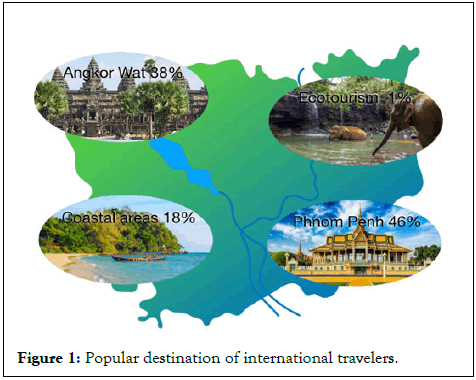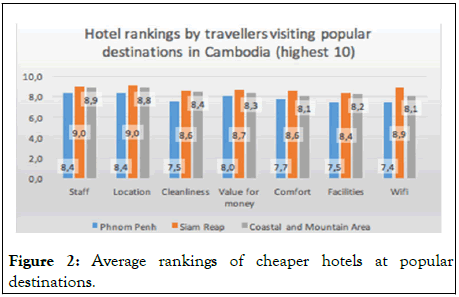Journal of Tourism & Hospitality
Open Access
ISSN: 2167-0269
ISSN: 2167-0269
Review Article - (2023)Volume 12, Issue 5
Tourism plays an important role in accelerating economic growth, and such creates employment opportunities, improves people's living standards, and increases national income, but also attracts foreign direct investment and international currency, contributing to socioeconomic development and decreasing poverty in the country. In the tourism industry, the success or failure of a tourist destination depends on providing safe and security for visitors. Safety and security in tourism have become the main topic that has been studied by researchers, media, and international tourism reports as a challenge for threatening tourism growth. This paper views the element of safety and security in tourism and hospitality. It will be clarifying the different safety and security. This paper seeks to answer: What are the main elements of the decision of travelers to Cambodia in terms of safety and security? it is expected this study contributes to travelers of decision making in choosing a destination.
Safety; Security; Tourism; Economics; Sport
Cambodia tourism plays an important role in accelerating economic growth, creating employment opportunities, improving people's living standards, and increasing national income [1]. In the last decade, tourism attracted foreign direct investment and international money flow, contributed to socioeconomic development, and targeted to decrease poverty in the country.
In the tourism industry, a tourist destination's success or failure depends on providing a safe and secure environment and activities for visitors, especially outdoor sports [2]. Even some travel advisers warn tourists, that violent crime is common in Cambodia, and foreigners have been the target of sexual assault and robbery. Robbery by bag-snatching from passing motorcycles or tuk-tuks is prevalent in cities and towns and can result in injury [3].
That’s why many tourists have prejudices and fears to visit Cambodia, which comes from a lack of information. Even sports tourists are hesitating if they could get help from tourism providers. A detailed analysis should be done to make Cambodia tourism more effective, especially on safety issues.
Tourism safety
The definition of safety was described by WTO, which is the condition of being protected from harm or other non-desirable outcomes, caused by non-intentional failure. A security issue can be becoming a victim of an armed robbery or maybe even physical or mental health, harmed, by the intentional actions of a human being. According to Tarlow, tourism safety and security is as a core attributes of a competitive tourism destination. Tourists’ past travel experience to specific regions both increases the intention to travel there again and decreases the intention to avoid areas, particularly risky areas. Perceived risks and safety were both found to be stronger predictors of avoiding regions than of planning to visit them [4,5].
Enormous increases in international travel by public sector employees and others, along with incidents of terrorism, accidents, and disease [6].
The results show that there are significant differences in perceptions of travel risk and safety, anxiety, and travel intentions among tourists from different countries. Tourists from the United States, Hong Kong, and Australia perceived more travel risk, felt less safe, and were more anxious and reluctant to travel than tourists from the United Kingdom, Canada, and Greece [7].
Tourism in Cambodia
The tourism industry is the country's second greatest source of hard currency after the textile industry. In 2018 more than 6 million tourists arrived in Cambodia, which contributed to 26% percent of the global economy (Figure 1). Three million of them went in the first half of 2018, an increase of 12.7 percent compared to the last year [8].

Figure 1: Popular destination of international travelers.
There were visitors from Asia (87%) over the period, which accounted for 31 percent of all inbound tourists. Most of the travelers (46%) are urban travelers, going to the capital city Phnom Penh, and 38% of them are cultural tourists to Angkor. Less tourists (15%) travel to beaches including Sihanoukville and Kampot in the Southeast. The main purpose of the arrivals was to visit cultural (Phnom Penh, Angkor Wat) and natural sites (coastal and mountain areas), but there were also a growing number of tourists who was interested mostly in adventurous activities, visiting eco-tourist and water sport areas [9]. According to a study with 512 international tourists visiting Cambodia especially Angkor, all symbolic, experiential, and functional consumptions have significantly positive effects on destination attachment and satisfaction, which in turn positively affect destination loyalty [10].
Goals and methods
• To collect research data on the opportunities and safety issues
of sport tourism in Cambodia.
• To collect feedback from tourists on safety issues visited
Cambodia before.
Our analysis was based on secondary sources, such as literature review and national statistics. We analyzed reviews published on booking.com and trip advisor websites from tourists, who spent nights in lower to high category hotels.
Sports tourism offers
Recently, Cambodians have started adopting Western sports and have come to love football and basketball. Among the citizens traditional sports such as Sepak Takraw and Bokator are very popular. To attract also tourists to learn about traditions, the world bokator centre was founded. For outdoor and extreme sports activities, the country has unique natural resources such as mountainous areas, which attract extreme sports tourists.
Some outdoor activities are provided as community based eco-touristic products, connected with tourism and health care services [11]. For example, in the countryside of Kampot mountainous areas with caves offer Climbodia’s tours with rock climbing, via ferrata, abseiling, and caving. The tours cater to all experiences and are led by trained professionals. The country is famous for adventurous bike rides, such as dirt biking, especially after the rainy season.
For beach activities, Cambodia provides a coastline of 435 km covering an area estimated at between 17,791 km² and 18,477 km² with optimal water temperatures [12]. Besides the traditional water sports, like sailing, and wakeboarding, beach services can be found in unique activities such as SUP, flyboarding, kite surfing, fun buggies, etc.
Safety issues
In Cambodia, some obstacles sports tourists should consider. There is a high crime rate in the country. Most of them happen in big cities like Phnom Penh, Siem Reap, and Sihanoukville. Foreign travelers are targeted by pickpockets day and night. The majority of the crimes are opportunistic and for financial gains, such as cell phone or motorbike thefts [13]. Health care is offered by both public and private practitioners and research has found that trust in health providers is a key factor in improving the uptake of health care services in rural Cambodia. In the countryside still exist HIV/AIDS, malaria, tuberculosis, and other diseases, although their numbers have declined significantly. In urban areas practicing sports on the streets are not always pleasant, because parked vehicles or food stands usually occupy Phnom Penh’s sidewalks, forcing pedestrians to walk on the streets and adding to the dangers. In the evening many streets have poor lighting. The common thing on the road is some drivers do not obey traffic laws. Drivers routinely run red lights and stop signs, drive the wrong way down one way streets, and frequently fail to turn their headlights on after dark. Parked vehicles or food stands usually occupy Phnom Penh’s sidewalks, forcing pedestrians to walk in the streets and adding to the dangers [14]. Road safety is a serious issue for sports tourists. Based on national road safety data, an average of up to seven deaths per day because of traffic accidents [15]. Some of the statistical data warn tourists should drive motorbikes very carefully, because of the high number of accidents [16]. The food safety issues have remarkable improvements because of the agriculture tourism linkages, especially in tourist regions, but hygienic control doesn’t reach world standards, especially buying food on the street (Figure 2). In unpopulated areas, outdoor sports activities can be still dangerous, because of the landmines, although the number of reported casualties has sharply decreased, from 800 in 2005 to 111 in 2013 (22 dead and 89 injured) [17].

Figure 2: Average rankings of cheaper hotels at popular destinations.
Cambodia travelers published mostly positive experiences on their experiences. Those who stayed in simple hotels without luxurious services ranked the location and the staff the highest. Although littering is still a big problem in the country, in the hotels the facilities are relatively clean and comfortable. The opinions of the tourist differ by region. They are more satisfied in Siam Reap than in the capital or coastal areas.
The research result demonstrates that Cambodia offers unique opportunities even for sports tourists. But to avoid some disappointment they need to focus on both safety and security aspects to fully grasp the economic and cultural differences which cause some safety problems to get adopted to the local environment. In the present country can be found almost all olympic sports, but the most popular among tourists are some traditional and extreme sports in an outdoor environment.
Exact data was difficult to find, how many sports tourists have been injured or had problems with environmental issues, but some statistical data caution. Social security is getting better, but at any time and any place, there can happen accidents because of bad traffic habits. When tourists want to do safe outdoor activities, they have to do it in an organized program by the local tour providers. Individual adventure tourists should be still careful, because of the unknown tropical environment, lack of developed facilities, health care services, or even landmines. Hopefully tourism industry in Cambodia will pay more attention to offering more safe products and continues increasing the reputation of the country.
Citation: Keo L, Banhidi M (2023) Safety and Security: Tourism Development Opportunities in Cambodia. J Tourism Hospit. 12:534.
Received: 29-Sep-2023, Manuscript No. JTH-23-23695; Editor assigned: 02-Oct-2023, Pre QC No. JTH-23-23695 (PQ); Reviewed: 16-Oct-2023, QC No. JTH-23-23695; Revised: 23-Oct-2023, Manuscript No. JTH-23-23695 (R); Published: 30-Oct-2023 , DOI: 10.35248/2167-0269.23.12.530
Copyright: © 2023 Keo L, et al. This is an open-access article distributed under the terms of the Creative Commons Attribution License, which permits unrestricted use, distribution, and reproduction in any medium, provided the original author and source are credited.